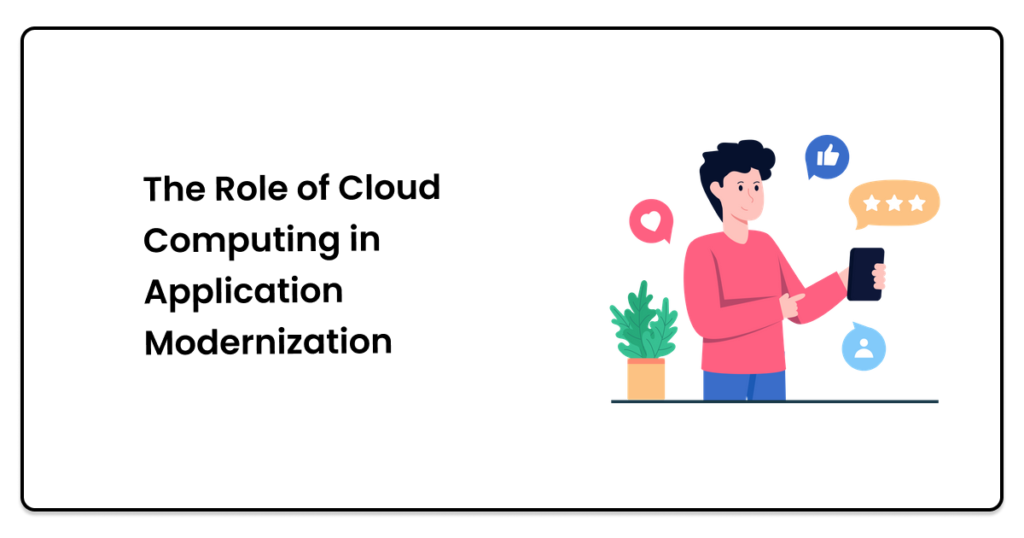The Role of Cloud Computing in Application Modernization

Introduction:
Application modernization refers to the process of updating or migrating legacy applications to modern systems that can meet the needs of today’s businesses. The modernization process can involve various activities such as code refactoring, re-platforming, re-architecting, and re-hosting. Cloud computing has emerged as a powerful tool in application modernization, offering a range of benefits, including scalability, flexibility, cost-effectiveness, improved performance, and enhanced security.

Benefits of Cloud Computing in Application Modernization:
Scalability and Flexibility: Cloud computing provides businesses with the ability to scale their applications up or down quickly and easily, depending on their needs. This ensures that applications can handle spikes in demand, without over-provisioning resources.
Cost-Effectiveness: Cloud computing eliminates the need for businesses to invest in expensive hardware and infrastructure, reducing capital expenditures. Additionally, businesses only pay for the resources they use, making cloud computing a more cost-effective option.
Improved Performance and Availability: Cloud computing enables businesses to leverage the power of modern infrastructure, resulting in improved application performance and availability. Additionally, cloud service providers offer Service Level Agreements (SLAs), ensuring that applications are available and performant at all times.
Enhanced Security and Compliance: Cloud service providers offer a range of security features and compliance certifications, ensuring that applications are secure and compliant with relevant regulations. This eliminates the need for businesses to invest in expensive security measures themselves.
Simplified Management and Maintenance: Cloud computing eliminates the need for businesses to manage and maintain their own infrastructure, reducing the burden on IT staff. Additionally, cloud service providers offer tools and services that simplify application management and maintenance.
Challenges of Cloud Computing in Application Modernization:
Legacy Systems Integration: Integrating legacy systems with modern cloud-based applications can be challenging. This is because legacy systems often use outdated technologies and data models that are not compatible with modern cloud architectures.
Data Migration and Management: Migrating data from legacy systems to modern cloud-based applications can be time-consuming and complex. Additionally, managing data in the cloud requires a different set of skills and tools than managing data on-premises.
Skills and Knowledge Gap: Adopting cloud computing in application modernization requires a different set of skills and knowledge than traditional IT environments. This can result in a skills and knowledge gap among employees, which can impact the success of application modernization projects.
Vendor Lock-In: Adopting a particular cloud service provider can result in vendor lock-in, which can limit the ability of businesses to switch to other providers in the future. This can be problematic if the chosen provider does not meet the evolving needs of the business.
Lack of Control and Customization: Cloud computing requires businesses to rely on the tools and services offered by cloud service providers, which can limit the ability of businesses to customize their applications to meet their unique needs.
Best Practices for Cloud Computing in Application Modernization:
Assess the Business Needs and Objectives: Before adopting cloud computing in application modernization, it’s important to assess the business needs and objectives. This ensures that the chosen cloud deployment model and service provider align with the goals of the business.
Develop a Comprehensive Cloud Strategy: Adopting cloud computing in application modernization requires a comprehensive cloud strategy that outlines the steps required to migrate applications to the cloud. This strategy should also address any potential risks and challenges.
Select the Right Cloud Deployment Model: The cloud deployment model selected should align with the business needs and objectives. Public, private, and hybrid cloud deployment models all have their own advantages and disadvantages.
Choose the Right Cloud Service Provider: The cloud service provider selected should offer the right set of tools and services to support the application modernization project. Additionally, the provider should offer strong security and compliance features.
Ensure Proper Data Management and Security: Data management and security should be a top priority when adopting cloud computing in application modernization. This requires businesses to implement appropriate security measures, backup and recovery processes, and data governance policies.
Train and Educate Employees: Adopting cloud computing in application modernization requires employees to have a different set of skills and knowledge. Providing training and education to employees can help bridge the skills and knowledge gap.
Monitor and Optimize Performance: After migrating applications to the cloud, it’s important to monitor and optimize performance to ensure that applications are performing as expected. This requires businesses to implement appropriate monitoring and optimization tools and processes.
Case Studies:
AWS Application Modernization Case Study: AWS helped a financial services company modernize its legacy applications by migrating them to the cloud. This resulted in improved application performance and reduced costs.
Azure Application Modernization Case Study: Microsoft Azure helped a healthcare provider modernize its legacy applications by migrating them to the cloud. This resulted in improved application performance and increased scalability.
Google Cloud Application Modernization Case Study: Google Cloud helped a retail company modernize its legacy applications by migrating them to the cloud. This resulted in improved application performance and increased agility.
Conclusion:
Cloud computing has emerged as a powerful tool in app modernization, offering a range of benefits, including scalability, flexibility, cost-effectiveness, improved performance, and enhanced security. However, adopting cloud computing in application modernization can also present challenges, such as legacy systems integration, data migration and management, skills and knowledge gap, vendor lock-in, and lack of control and customization. To ensure the success of application modernization projects, businesses should adopt best practices, such as assessing the business needs and objectives, developing a comprehensive cloud strategy, selecting the right cloud deployment model and service provider, ensuring proper data management and security, training and educating employees, and monitoring and optimizing performance.




